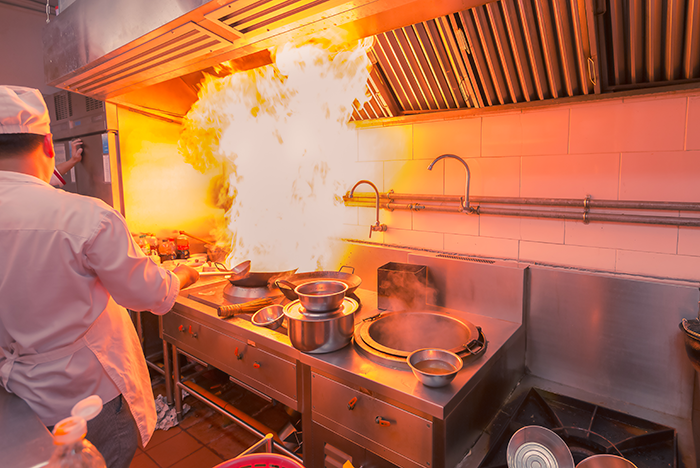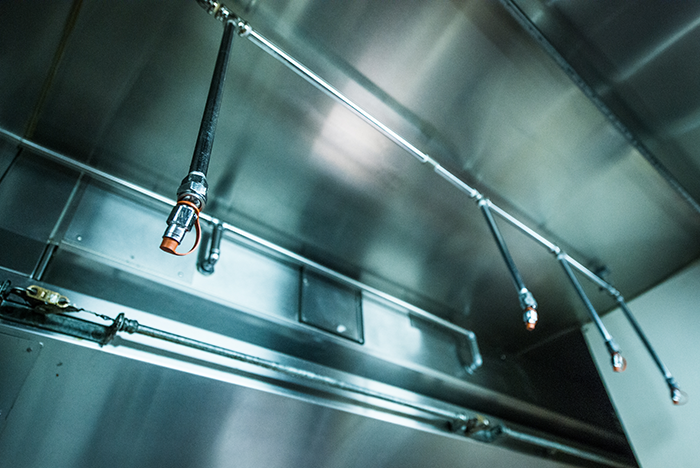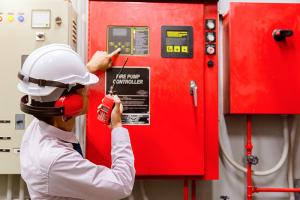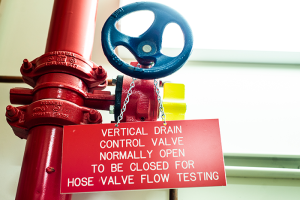Safely responding to health care facility kitchen fires

Kitchen fires are the leading cause of fires in health care facilities.
Image from Getty Images
Fire safety is paramount in any environment but especially in commercial kitchens where the risk of Class K fires, which involve cooking oils and fats, is significant. According to the Federal Emergency Management Agency’s National Fire Incident Reporting System 5.0, between 2014 and 2016 cooking caused 71% of all medical facility fires, making it the leading cause for that period. These fires can escalate rapidly if not promptly controlled, leading to damage, injuries and even loss of life.
Class K fires can be extremely dangerous and difficult to extinguish using traditional water or dry chemical extinguishers. Using water can cause the burning oil to splatter and spread the fire, while dry chemicals may not effectively smother the flames.
Following the fire codes
The National Fire Protection Association’s NFPA 10, Standard for Portable Fire Extinguishers, provides guidelines for the use of portable fire extinguishers, including Class K extinguishers. Class K portable fire extinguishers are specifically designed to combat these types of fires effectively. These extinguishers use a special extinguishing agent, such as potassium bicarbonate, that reacts with the cooking oil or fat to form a foam-like blanket that smothers the fire and prevents reignition. Class K extinguishers should be installed no greater than 30 feet away from any cooking equipment presenting a fire hazard. This ensures quick access in the event of a fire. Mounting heights should adhere to NFPA 10 guidelines (based on weight of the extinguisher) to facilitate easy retrieval and operation.
Automatic kitchen suppression systems, or hood suppression systems, are designed and installed to automatically detect and suppress fires in commercial cooking environments. These systems typically consist of heat detectors (or a combination of heat detectors and manual pull stations), suppression agents, distribution piping and nozzles installed above the cooking equipment. In kitchens utilizing natural gas for cooking equipment, the suppression system is also integrated with the gas piping to shut off the flow of fuel to prevent the further spread of fire.

Automatic kitchen supression systems are the first line of defense to put out kitchen fires.
Image courtesy of the American Society for Health Care Engineering
Because of these unique fire protection features, NFPA 96, Standard for Ventilation Control and Fire Protection of Commercial Cooking Operations, requires that “Instructions shall be provided to new [kitchen] employees on hiring and to all employees annually on the use of portable fire extinguishers and the manual actuation of the fire-extinguishing system.”
So, how should staff be trained to respond to Class K fires when both an automatic kitchen suppression system and a Class K portable fire extinguisher are present?
NFPA 10, Section 5.5.4.5.3, specifies that if a hazard is protected by an automatic fire protection system, facilities should place a placard near the extinguisher that communicates that the fire protection system “shall be actuated prior to using the fire extinguisher.” This signage reminds kitchen staff that the first line of defense in a Class K fire is the automatic extinguishing system, and only when that is not effective should the Class K portable fire extinguisher be used.
RACE to safety
In health care, staff are trained to respond to a fire using the RACE and PASS acronyms. RACE stands for rescue, alarm, contain and extinguish and/or evacuate. PASS stands for pull the pin, aim, squeeze and swipe. In a commercial kitchen environment both these methods apply but are more complex given the unique fire protection features involved.
Here are the components of an effective RACE program for commercial kitchens:
Rescue
- Rescue individuals who are in immediate danger from the fire, ensuring that they are a safe distance from the hazard.
Detect and alarm
- If an automatic kitchen suppression system is present, it is equipped with heat detectors that sense elevated temperatures indicative of a fire, activating automatically to release the suppression agent to extinguish the fire. When the suppression system is activated, the fire alarm will also be activated automatically.
- If a fire is present in an area covered by the automatic kitchen suppression system, but the suppression system does not activate automatically, staff should manually activate it by pulling on the suppression system’s manual pull station. This will also automatically sound the fire alarm.
- If the fire is in an area not covered by the automatic kitchen suppression system, staff shall manually activate the fire alarm system by pulling on a manual fire alarm pull station, typically located near exits.
Contain
- When the fire alarm system is activated, fire resistance-rated doors and smoke barrier doors will automatically close to help contain the fire and spread of smoke. If the fire is in an area that can be further contained, staff should take steps to do so, such as closing additional doors and removing flammable or combustible objects from the vicinity of the fire if safe to do so.
Extinguish and/or evacuate
- Assess the situation. If the fire is in an area not covered by the automatic kitchen extinguishing system or if the system was unsuccessful in extinguishing the fire, evaluate the size and severity of the fire. If the fire is small and contained and can safely and confidently be extinguished, proceed to the next step.
- Retrieve the fire extinguisher. Quickly retrieve the nearest Class K fire extinguisher. Remember, safety should always be the top priority, no one should ever put themselves at risk to retrieve an extinguisher.
- Approach the fire. Users should approach the fire from a safe distance (Class K extinguishers are designed to be used from a distance of 10 to 12 feet), keeping a clear escape route behind them. Do not attempt to extinguish the fire if it has spread beyond its initial point of origin or if it poses a threat to safety.
- PASS. This where the pull, aim, squeeze, sweep actions come in. First pull the pin, then aim the nozzle of the extinguisher at the base of the flames, not at the flames themselves. Squeeze the handle to discharge the extinguishing agent and sweep the nozzle from side to side, covering the entire area of the fire with the extinguishing agent.
- Monitor the area. After extinguishing the fire, monitor the area for any signs of reignition. If the fire rekindles or if it is unclear whether it has been fully extinguished, evacuate the area.
- Evacuate. If evacuation is necessary, follow organizational policies and procedures to make sure the area people are evacuating to is safely located in a different smoke compartment.
Perfecting the plan
Health care facilities count on this suppression procedure to work when it is needed most, and so, to guarantee it is kept in good working order, the codes require periodic inspection, testing and maintenance.

A sign posted above Class K fire extinguishers notifies staff that portable extinguishers should be used only the event of an automatic fire suppression system failure.
Image courtesy of the American Society for Health Care Engineering
Regular inspection and maintenance of Class K portable fire extinguishers is addressed in NFPA 10, which outlines inspection frequencies and procedures, including monthly visual inspections and annual maintenance by qualified professionals.
Regular inspection, testing and maintenance of automatic kitchen extinguishing systems is addressed in NFPA 96, which requires inspection every six months. And if the suppression system has been activated to extinguish a fire, proper post-fire procedures should be followed. This includes inspection and maintenance of the system to ensure its readiness for future incidents.
Ensuring fire safety in health care facilities, particularly in commercial kitchens, is imperative given the prevalence of Class K fires. These fires pose significant risks to both property and lives. To effectively mitigate such hazards, a multilayered approach is essential, incorporating both automatic kitchen suppression systems and Class K portable fire extinguishers.
Automatic kitchen suppression systems serve as the primary line of defense against Class K fires, swiftly detecting and suppressing flames to prevent escalation. However, in the event of system failure or fire occurrence in uncovered areas, the presence of Class K extinguishers becomes crucial. Proper training ensures staff can respond effectively to such emergencies, emphasizing the sequential activation of suppression systems before resorting to manual extinguishment.
Regular inspections, testing and maintenance of suppression systems and extinguishers are paramount to ensure their functionality during critical moments. By integrating robust fire safety measures and comprehensive training protocols, health care facilities can significantly reduce the risk posed by kitchen fires, safeguarding both occupants and infrastructure from potential devastation.
What about extended wand-type Class K fire extinguishers?
Prohibited from being manufactured after Jan. 1, 2002, some facilities may still have some extended wand-type Class K fire extinguishers in use. If so, note that the method for using the fire extinguisher may be different than the pull, aim, squeeze, sweep or PASS method. Please refer to the manufacturer’s instructions for the proper usage of extended wand-type Class K fire extinguishers.
Leah Hummel, AIA, CHFM, CHC, is a senior associate director of the American Society for Health Care Engineering, Regulatory Affairs.




